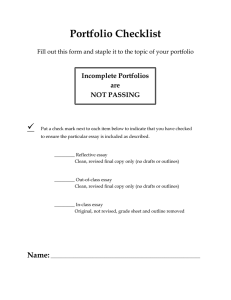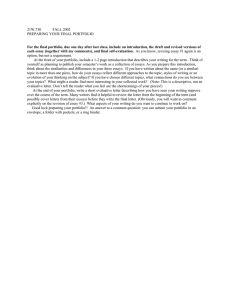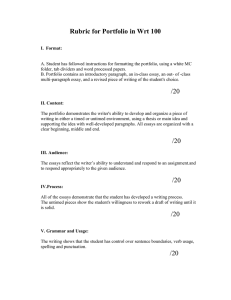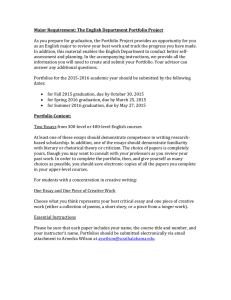Portfolio Information for Students Handout
advertisement
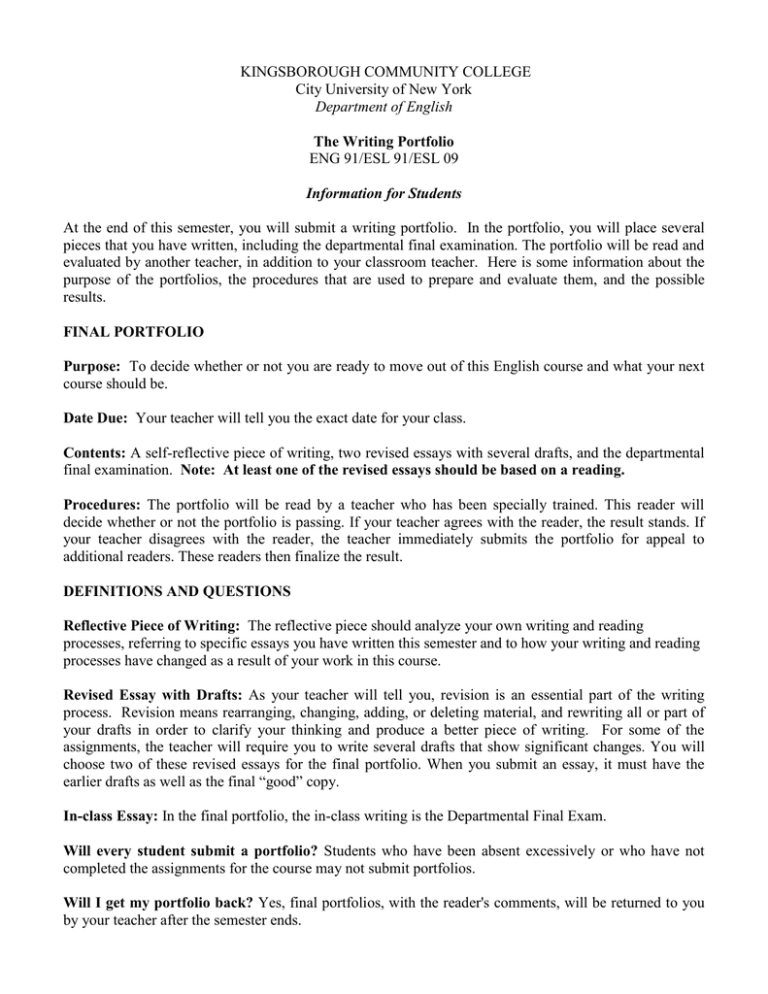
KINGSBOROUGH COMMUNITY COLLEGE City University of New York Department of English The Writing Portfolio ENG 91/ESL 91/ESL 09 Information for Students At the end of this semester, you will submit a writing portfolio. In the portfolio, you will place several pieces that you have written, including the departmental final examination. The portfolio will be read and evaluated by another teacher, in addition to your classroom teacher. Here is some information about the purpose of the portfolios, the procedures that are used to prepare and evaluate them, and the possible results. FINAL PORTFOLIO Purpose: To decide whether or not you are ready to move out of this English course and what your next course should be. Date Due: Your teacher will tell you the exact date for your class. Contents: A self-reflective piece of writing, two revised essays with several drafts, and the departmental final examination. Note: At least one of the revised essays should be based on a reading. Procedures: The portfolio will be read by a teacher who has been specially trained. This reader will decide whether or not the portfolio is passing. If your teacher agrees with the reader, the result stands. If your teacher disagrees with the reader, the teacher immediately submits the portfolio for appeal to additional readers. These readers then finalize the result. DEFINITIONS AND QUESTIONS Reflective Piece of Writing: The reflective piece should analyze your own writing and reading processes, referring to specific essays you have written this semester and to how your writing and reading processes have changed as a result of your work in this course. Revised Essay with Drafts: As your teacher will tell you, revision is an essential part of the writing process. Revision means rearranging, changing, adding, or deleting material, and rewriting all or part of your drafts in order to clarify your thinking and produce a better piece of writing. For some of the assignments, the teacher will require you to write several drafts that show significant changes. You will choose two of these revised essays for the final portfolio. When you submit an essay, it must have the earlier drafts as well as the final “good” copy. In-class Essay: In the final portfolio, the in-class writing is the Departmental Final Exam. Will every student submit a portfolio? Students who have been absent excessively or who have not completed the assignments for the course may not submit portfolios. Will I get my portfolio back? Yes, final portfolios, with the reader's comments, will be returned to you by your teacher after the semester ends. What is a Passing Level I Portfolio? General Goal: Students should be able to write fluently (at some length and clearly) about personal experience and readings. Writing Process The reflective piece of writing shows that you have thought about yourself as a learner. You have explored in writing such things as: your ways of working, past and present; your progress; difficulties; your experience of writing a particular piece, or reading a certain book or article; your reactions to the course; ways in which you see yourself changing as a learner. First draft shows an effort to get ideas down on paper. Although a first draft is often “rough,” it is clear that you have spent time writing and developing ideas. Drafts show that you have continued to think about and develop the topic from first draft to final draft. Each draft shows changes (e.g., additional information, a new or clearer arrangement of ideas, improved or more appropriate language) that signal you have attempted thoughtful revision. Drafts show that you have consulted with other readers (peers, your teacher), and considered their questions and comments. Drafts have been labeled (first draft, second draft, etc.) and dated so your reader has a sense of the time progression from draft to draft. Final draft is stapled on top of the others and has the look of a college essay. Finding and Organizing Material Write enough to respond meaningfully to a topic. By the end of 91, you should write at least three-page essays, although some students will write considerably more. Be able to explain causes and/or effects of particular acts, see situations from different points of view, make meaningful comparisons, and analyze the meaning of actions or events. In the reading-based essay(s), you refer to what you have read and choose appropriate quotations, paraphrases, specific details, and/or brief summaries to support the ideas in your essay. Connect your references to the reading with your own ideas about the topic. Include the author’s name and the title of the reading. Use quotation marks to indicate direct quotations. (continued on next page) Arrange material so that it is logical and keeps the reader's needs in mind, including: having a clear focus, grouping related ideas or details into paragraphs, composing clear, understandable sentences, trying to interest the reader. Use vocabulary that is adequate for the subject being discussed. Correctness Consistently use capital letters correctly. Usually punctuate sentence boundaries correctly. Usually form plural nouns, both regular and irregular, correctly. Use correct word order and word forms, except for occasional errors in in-class writing. Use verb tenses appropriately although there may be occasional errors in form. Also use verb forms correctly in other parts of the sentence, such as after "to" or after a preposition. Spell common words correctly, especially in revised essays.
